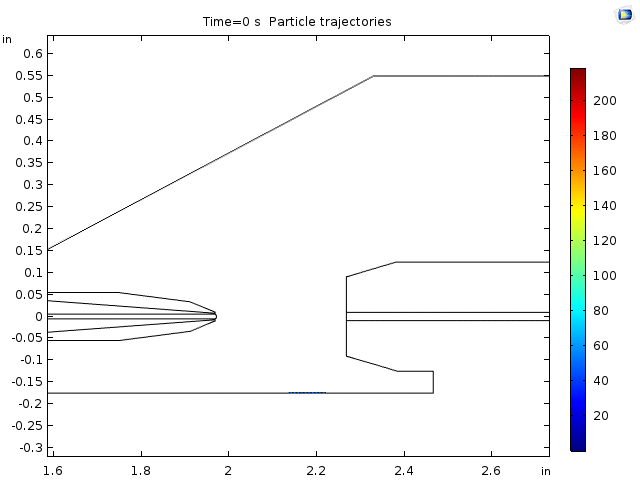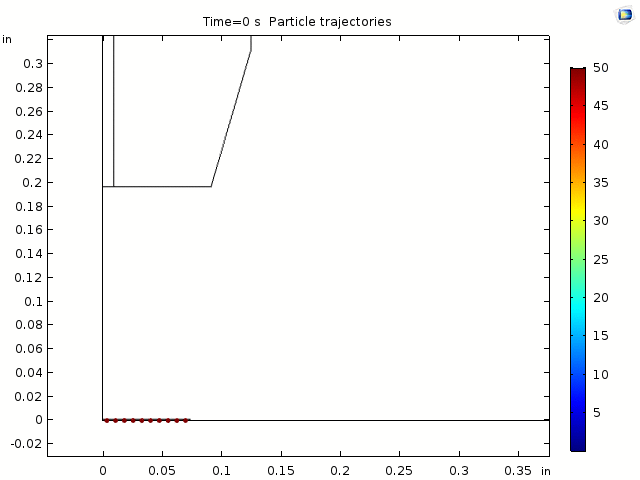Atmospheric Surface Chemistry
Ambient Sampling Techniques for Mass Spectrometry
Sampling surfaces for mass analysis of the compounds contained has proven to be useful for a variety of analytical areas. However, for techniques using high and ultra-high vacuum conditions, there is a considerable barrier to load samples with ease. Laser-induced acoustic desorption atmospheric pressure photoionization (LIAD-APPI) has recently been developed as a tool to probe complex mixtures deposited on thin (12.7 µm) foils. In this technique, a laser back-irradiates a foil initiating processes that desorb intact molecular species on the opposite surface. These gaseous molecules are then ionized via APPI processes initiated by our efficient VUV radiation generating microplasmas. Computational-fluid dynamic and particle motion simulations have been performed to optimize sampling configurations for collection of the generated ions.

Simulation 1: Sweep jet collection LIAD-APPI geometry with simulated motions of attogram particles under turbulence conditions.

Simulation 2: Forward ejected collection LIAD-APPI geometry with simulated motions of attogram particles under turbulence conditions.
Liquid Jets
Unlike probing reactions on ice surfaces, investigating air/liquid interfaces present several challenges. This is because traditional surface science techniques require an ultra high vacuum environment to prevent distortion of information due to interference from equilibrium vapor above the liquid surface during data acquisition. The liquid jet technique facilitates the direct study of continually renewed liquid surfaces in high vacuum, thereby preventing the constant changing of the properties and composition of the liquid surface due to the aging process (diffusion of impurities or liquid constituent). A linear time-of-flight mass spectrometer has been used to monitor ion ejection during laser irradiation of liquid jet containing aqueous solutions and pure water. Since these ions are ejected exclusively from the surface of the liquid and the cluster distributions observed are influenced by the local structure, these experiments provide a sensitive probe of the liquid vacuum interface of these solutions.
Halogenated Compounds on Ice
Processes at the air-water/ice interface are known to play a very important role in the release of reactive halogen species with atmospheric aerosols serving as catalysts. The ability to make different types of ice with various morphologies, hence, different adsorption and surface properties in vacuum, provide a useful way to probe the catalytic effect of ice in atmospheric reactions. Studies of reactions on both ice and liquid surfaces at ambient conditions are usually complicated by the rapid desorption and adsorption processes due to the high evaporation rates at the surface. To gain a better understanding and improve modeling of several atmospheric relevant reactions, it is therefore important to develop laboratory techniques that provide an opportunity to investigate non-thermal reactions on both ice and liquid surfaces. Detailed investigation of the interactions of atmospheric relevant molecules (methyl iodide and hydrogen chloride) on water ice at low temperature in UHV conditions has been carried out. These interactions were studied using different techniques such as temperature programmed desorption (TPD), electron stimulated desorption (ESD) and resonance enhanced multiphoton ionization (REMPI).
